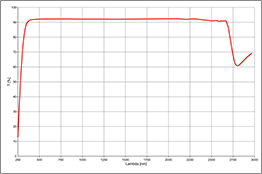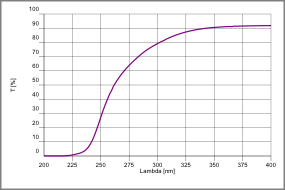AF 32® eco – Alkali-free alumina-borosilicate thin glass
Special Properties
- Alkali-free in synthesis*
- Low thermal expansion coefficient
close to that of silicon - Very smooth surfaces
- High optical transmittance
- Excellent surface quality and flatness
- Low micro-roughness < 1 nm (RMS)
- Application temperature of up to 650 °C
- AF 32® eco can be laser cut
Typical Applications
- Alkali-free glass wafers for semiconductor technology
- MEMS (Micro-Electro-Mechanical Systems)
- Wafer for Microarrays
- Electronic packaging
- Covers for optoelectronics and optical sensors
- Substrates for hybrid electronics
- Advanced electronic display technology
- Glass interposer
- Glass spacers
- Alkali-free microscope glasses
Related glass types
- Alkali-free materials:
- EAGLE2000 (boro-aluminosilicate glass)
- 1737F (boro-aluminosilicate glass)
- AF 45 (modified borosilicate display glass)
- 7059 / 7059F (low alkali barium-borosilicate glass)
- Thin glasses:
- D 263 T (thin and ultra-thin borosilicate display glass)
- AS 87 eco (ultra-thin aluminosilicate glass)
- MEMpax® (thin borosilicate glass)
- 0211 (alkali reduced borosilicate thin glass)
- Selected float glass (soda-lime thin glass)
Request for Quotation
![]() Available in 48-hour express service
Available in 48-hour express service
AF 32® eco is an advanced flat alumina-borosilicate glass material that is alkali-free in synthesis*. It is fabricated by a down-draw manufacturing process. SCHOTT developed this technology to allow the production of ultra-thin glass materials with very high quality. AF 32® eco features a low micro-roughness of typically < 1 nanometer (RMS) and has a coefficient of thermal expansion of 3.2 x 10-6, which is very close to silicon. This property opens up a wide range of glass wafer applications in the semiconductor industry. AF 32® eco glass materials are often used for wafers in MEMS applications (Micro-Electro-Mechanical systems).
Likewise, there are numerous optical applications for this thin glass in science and research. Our company manufactures alkali-free microscope slides, cover slips, glass wafer components, and various optics for photonics research based on this high-quality material.
High light transmission for the visible wavelength spectrum and for infrared light up to approx. 2700 nm allows for many interesting optoelectronic applications based on this glass. Besides, the smaller thicknesses offer excellent optical transmission in the UVB range.
AF 32® is cut with CNC precision using diamond tools or laser-cutting processes. The glass is currently available in a thickness range of 0.10 to 0.50 mm. (See the standard thickness table.)
To request windows, substrates, wafers, microscope slides, cover slips, or any other optics made of AF 32® eco alkali-free* glass with specific dimensions, please choose a thickness in the thickness table or use the button below.
Note: *According to SCHOTT, an alkali content of 0.2 weight percent of the glass might be possible, resulting from small alkali traces in the raw materials and the production process.
Specifications
Spectral curve of SCHOTT AF32® eco
at 0.5 mm glass thickness

Show transmission curve at 0.5 mm thickness
UV-Transmission of SCHOTT AF32® eco

Show uv transmission
Standard Thicknesses
Please click on a glass thickness to request a quote:Thickness (mm) |
Tolerance (mm) |
|
|---|---|---|
| 0.100 | ±0.015 | ✔ |
| 0.200 | ±0.020 | ✔ |
| 0.300 | ±0.020 | ✔ |
| 0.400 | ±0.030 | ✔ |
| 0.500 | ±0.030 | ✔ |
| The thicknesses marked with "✔" are also available within 48–hour express service. | ||
Optical Properties
- Abbe number: ve= 62.4
Refractive Index of AF 32 eco glass |
||
|---|---|---|
Description |
Wavelength (nm) |
Refractive Index |
ng |
436 |
1.5200 |
nF' |
480 |
1.5161 |
nF |
486 |
1.5156 |
ne |
546 |
1.5119 |
nd |
587.5 |
1.5100 |
nD |
589.3 |
1.5099 |
nC' |
644 |
1.5079 |
nC |
656 |
1.5075 |
Mechanical Properties
- Density: 2.43 g/cm3
- Young's modulus E: 74.8 kN/mm2
- Stress optical coefficient C:
3.1 × (1.02 x 10-12 m2/N) - Poisson's ratio μ: 0.238
- Torsion modulus G: 30.2 kN/mm2
- Knoop hardness HK0.1/20: 490
- Vickers hardness HV0.2/25: 540
Thermal Properties
- Coefficient of thermal expansion:
3.2 × 10-6/K (20 °C ; 300 °C) - Thermal conductivity in W/(m × K): 1.16 (89 °C)
- Viscosities:
- Softening Point (107.6 dPa): 970 °C
- Annealing Point (1013 dPa): 731 °C
- Strain Point (1014.5 dPa): 686 °C
- Transformation temperature Tg: 717 °C
Chemical Properties
- Hydrolytic resistance according to DIN ISO 719:
- Resistance class HGB 1
- Equivalent of alkali (Na2O) per g of glass grains: 10 μg/g
- Acid resistance according to DIN 12 116:
- Resistance class 4
- Half surface weight loss after 6 h:
> 60 mg/dm2
- Alkali resistance according to DIN ISO 695:
- Resistance class A3
- Surface weight loss after 3 h:
210 mg/dm
Electrical Properties
Dielectric Constant (permittivity) εr |
||||||
|---|---|---|---|---|---|---|
| Frequency in GHz | 0.001 |
1.0 |
2.0 |
5.0 |
24 |
77 |
5.1 |
5.1 |
5.1 |
5.1 |
5.1 |
5.0 |
|
Loss Tangent tan(δ) x 10-4 |
||||||
|---|---|---|---|---|---|---|
| Frequency in GHz | 0.001 |
1.0 |
2.0 |
5.0 |
24 |
77 |
28 |
35 |
39 |
49 |
90 |
110 |
|
- Specific AC-Volume Resistivity ρD (Ω x cm):
- 7.9 × 1011 (250 °C / 50 Hz)
- 1.1 × 1010 (350 °C / 50 Hz)
- Electric DC-volume resistivity ρD:
- 7.9 × 1011 Ω × cm (250 °C)
- 1.1 × 1010 Ω × cm (350 °C)
- 1.5 × 108 Ω × cm (500 °C)
© 1994 – 2025 Präzisions Glas & Optik GmbH
Last update: November 27, 2024


